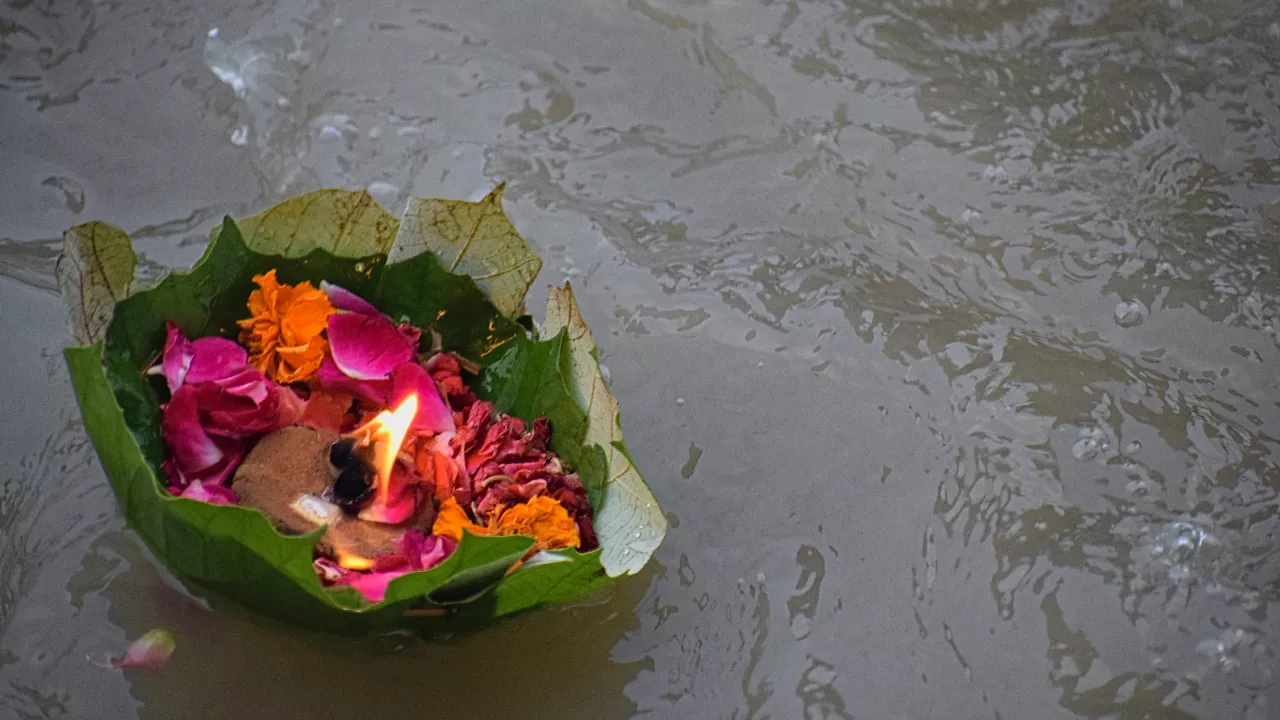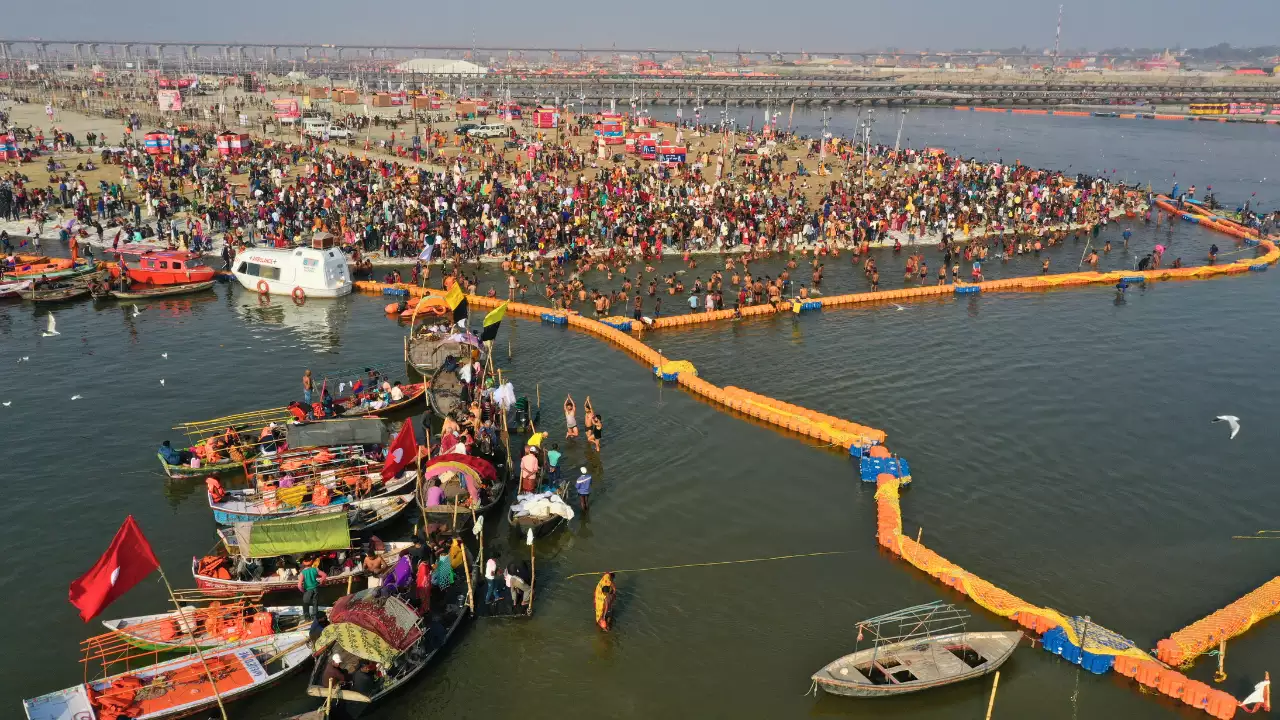Har Har Gange!
The Living Goddesses: Understanding the Soul of a Rivers sacred for Pitrupaksha
Before we speak of specific rivers, we must first shift our perception. In our Dharma, every river is a mother, a goddess, a Devi. They are revered as the “mothers of the universe” and the “destroyers of all sin.” [Brahma Purana Part 1.pdf (p. 138)] The ocean itself, into which they all flow, is the abode of Lord Narayana. Therefore, to enter a holy river is to enter the very lap of the divine.
These rivers are not just flowing water; they are flowing shakti (divine energy). They carry the spiritual merit of the holy mountains from which they are born, the blessings of the countless sages who have performed penance on their banks, and the prayers of the millions of pilgrims who have bathed in their waters for millennia. They are living, breathing reservoirs of spiritual power.
The Great Purifiers: Why Rivers are Central to Shradh

The period of Pitrupaksha is a time of deep remembrance and offering. The goal is to purify our ancestors of any lingering karmic burdens and to nourish their souls, helping them on their journey. The holy rivers are the perfect partners in this sacred duty for several profound reasons.
1. The Power
The very first step of any sacred rite is atma-shuddhi, the purification of the self. A holy bath, or snan, in a sacred river is the most powerful form of purification imaginable. Our scriptures state that a single dip can wash away the sins accumulated over countless lifetimes. [Garuda Purana Pt_ 1.pdf (p. 179)] When you, the performer of the Shradh, are so deeply purified, the offerings you make are imbued with immense potency and are readily accepted by the ancestors.
2. The Perfect Medium for Tarpan (Water Oblations)
Tarpan, the offering of water mixed with sesame seeds, is a core ritual of Pitrupaksha. It is an act that quenches the spiritual thirst of the ancestors. When you perform Tarpan standing in a holy river, you are not just offering any water. You are offering the very body of a goddess, a liquid form of grace, back to the cosmos in the name of your ancestors. The river herself becomes the offering and the medium, a direct and powerful conduit to the ancestral realm. The Pitrs are said to be “everlastingly satisfied” by such an offering. [Padma Purana-all 10 parts.pdf (p. 213)]
3. The Final Journey for the Pinda (Food Offering)
After the Pindas (rice balls) are offered on the riverbank, they are respectfully immersed into the flowing waters. This is a deeply symbolic and beautiful act. As the river gently carries the Pinda away, it is a visual prayer, a depiction of the river goddess herself carrying the soul of the ancestor on its final, liberating journey.
A Garland of Grace: The Most Sacred Rivers for Ancestral Rites

While all rivers are revered, our scriptures have highlighted a few as being exceptionally potent for Pitrupaksha rites.
Ganga: The Supreme Mother of Liberation
The Ganga is, without a doubt, the most sacred of all rivers. Born from the feet of Lord Vishnu and held in the locks of Lord Shiva, she is the Tripathaga, the river that flows through all three worlds—heaven, earth, and the netherworld. [Padma Purana-all 10 parts.pdf (p. 216)] This makes her the ultimate bridge between us and the ancestral realm.
- Her Promise: The scriptures make a profound promise: as long as a single bone of a deceased person remains in the Ganga, that soul resides in heaven. [Padma Purana-all 10 parts.pdf (p. 329)] Her power to grant liberation is absolute. A Shradh performed on her banks is a direct appeal for Moksha.
Yamuna: The Daughter of the Sun God
Revered as the daughter of the Sun God, Surya, the Yamuna’s dark waters are considered supremely purifying. She is especially sacred to the Pitrs and is believed to destroy great sins. Her presence at the Triveni Sangam in Prayagraj, where she merges with the Ganga and the subtle Saraswati, creates one of the most powerful Tirthas on Earth for ancestral rites.
Saraswati: The River of Knowledge and Purity
Though she now flows primarily as a subtle, underground river, the Saraswati is the embodiment of knowledge and purity. To invoke her during Shradh is to pray for the wisdom and enlightenment of our ancestors. At the Triveni Sangam, her presence completes the divine trinity of rivers, making the offerings there supremely powerful.
Narmada: The Daughter of Lord Shiva
Born from the very body of Lord Shiva, the Narmada is known as the “Southern Ganga.” It is said that while one must bathe in the Ganga for purification, the mere sight (darshan) of the Narmada is enough to wash away sins. [Padma Purana-all 10 parts.pdf (p. 20)] Every stone in her riverbed is considered a living Shiva Lingam. Performing Shradh on her banks is a direct offering at the feet of Mahadev.
Other Holy Mothers: Godavari, Kaveri, and More
The sacred geography of our land is blessed with many other divine rivers, each with its own profound power for ancestral rites. The Godavari is known as the Ganga of the South. The Kaveri is revered for her ability to fulfill cherished desires. The Sindhu, the Tapi, the Gomati—each is a loving mother waiting to receive your offerings.
The Power of Confluence (Sangam)

If a single river is so powerful, imagine the sanctity of a place where two or more holy rivers meet. These confluences, or sangams, are considered spiritual powerhouses. The energies of the goddesses merge, creating a vortex of immense spiritual energy. A Shradh performed at a sangam, like the Triveni Sangam at Prayagraj, is said to yield “undecaying merits” and is one of the most potent acts a descendant can perform. [Padma Purana-all 10 parts.pdf (p. 17)]
A Pandit’s Final Counsel: Connecting from Home
After hearing of the glories of these holy rivers, your heart may yearn to be on their banks. This is a blessed and natural feeling. But what if you cannot physically travel?
Do not be disheartened. The goddesses who manifest as these rivers are also cosmic principles. They exist within you. You can connect with their power from anywhere in the world.
- The Power of Invocation: When you perform Shradh at home, take a clean vessel of water. Before you begin, close your eyes and with a sincere heart, invoke the presence of these holy rivers into that water. Chant the simple but powerful mantra:
“Gange cha Yamune chaiva Godavari Saraswati, Narmade Sindhu Kaveri jalesmin sannidhim kuru”
(O Ganga, Yamuna, Godavari, Saraswati, Narmada, Sindhu, and Kaveri, please manifest your sacred presence in this water.)
By this act of faith, the water in your vessel becomes charged with the energy of all these Tirthas. - The Modern Bridge: In our current age, for those who wish for the rites to be performed physically on these sacred banks, many reputable organizations like pitrupaksha.org offer this sacred service. They can perform the Shradh on your behalf, in your name, at a holy river, ensuring that the amplified blessings of the Tirtha reach your ancestors.
Conclusion: A Dip in the River of Gratitude
The rivers sacred for Pitrupaksha are our greatest allies in our sacred duty. They are our compassionate mothers, who lovingly accept our humble offerings and carry our prayers to the farthest shores of the ancestral realm. To perform Shradh on their banks is to participate in a timeless tradition, a sacred flow of gratitude that has nourished the spiritual roots of our civilization for millennia.
It is to take a dip, not just in water, but in an ocean of divine grace, ensuring that your ancestors are at peace and that their blessings flow back to you, as surely and as ceaselessly as the river flows to the sea.
Jai Ma Gange!
